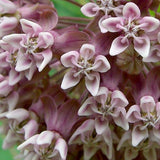Common Milkweed
Asclepias syriaca
Help protect monarch butterflies with this native plant!
With beautiful pink and purple flowers, this perennial milkweed is from southern Canada and much of the United States from the east coast to the Rocky Mountains. 3-4' tall, and 1-2' wide.
Monarch butterflies from northeastern North America fly thousands of miles south to overwinter in sacred firs on mountains 62 miles northwest of Mexico City, in sanctuaries protected by the Mexican government. In the spring, they will then fly to Texas to a milkweed patch to lay eggs, and four or five generations later, they will make it to the northeast again, to another milkweed patch. The caterpillars only eat milkweed. It serves them well! They use the toxic steroids (called cardenolides) of milkweed plants to taste horrible to predators.
Suburban development has diminished this once ever-present plant. Please plant milkweed if you don't already - you'll help this endangered indigenous American butterfly continue to make its annual trip by creating a landing place - a sanctuary.
Also called: common milkweed, butterfly flower, silkweed, silky swallow-wort, and Virginia silkweed.
Flower photo by Jason Hollinger (Creative Commons)
Pod photo by H. Zell (CC)
Seeds per pack: 50
Germination rate: 38% (total viability: 90%) on 08/13/2025 (read more about viability)
Planting / harvesting notes
When you receive your milkweed seeds, they'll need at least a month of cold treatment (known as cold stratification). Consider direct sowing in the fall or winter onto prepared ground. Alternatively, sow them about 1/8th inch deep into moist potting soil and keep them in a cold, dark place for 4-6 weeks. Another option is to place the seeds in a moist paper towel in a plastic bag in your refrigerator for 4-6 weeks. After one of these cold treatments, seeds should be placed in warm soil (70 degrees), and they should germinate in a week or two. Without stratification, germination will be very low. The seeds of plant have adapted to require winterization for proper germination.
Seed keeping notes
Wait for the seed pods (follicles) to fully dry out and start to burst open before gathering seeds. If you wait too long, the seeds will take flight on their silks on the wind! Continue drying seeds completely in a dark, ventilated place so that they do not rot in storage. Consider storing your fully dry milkweed seeds in labeled paper bags in the refrigerator, or immediately replanting in your garden or field for growth the following year.





